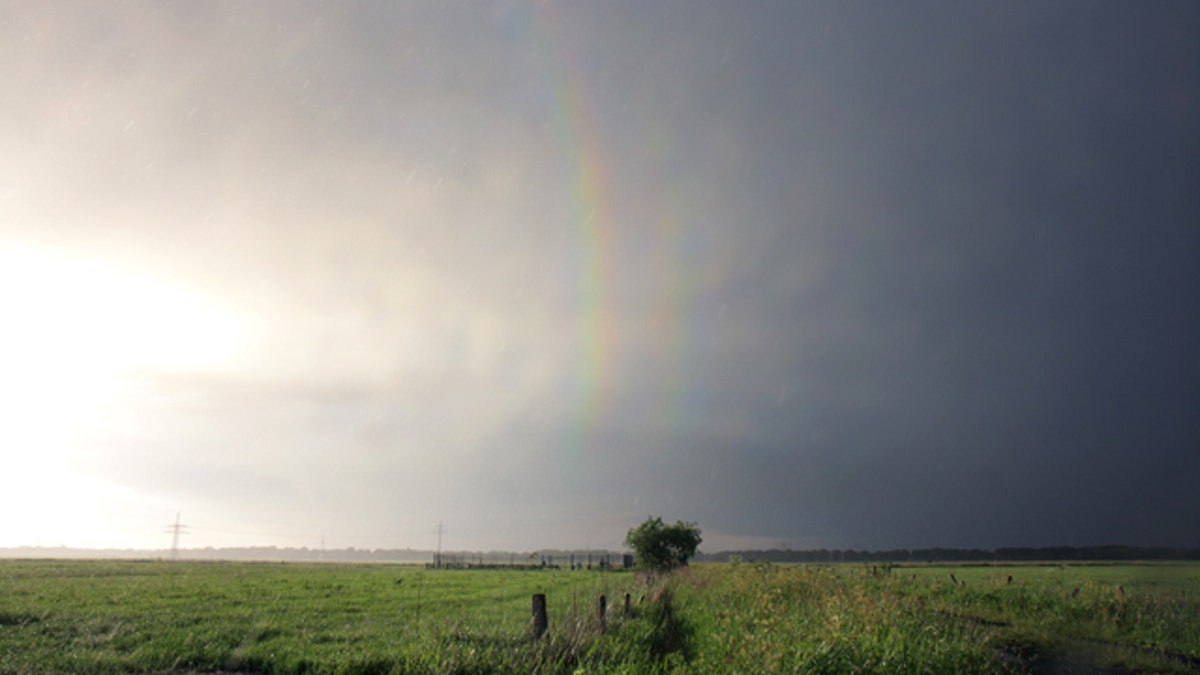
The first picture ever of a quadruple rainbow shows the third-order (left) and fourth-order rainbows (right) -- the first two aren't included in the image. (Michael Theusner/Applied Optics)
Viral video star Paul Vasquez was launched to Internet fame when he posted a video of his overly emotional response to seeing a double rainbow in Yosemite National Park. Now, it looks like he may need to grab another box of tissues.
A new meteorological model has allowed people to find and capture an incredibly rare visual phenomenon – a tertiary, or triple, rainbow. And just recently, the method has allowed an amateur storm chaser in Germany to take it one step further and capture an even more exceptional event – a quadruple (quaternary) rainbow.
The technique was developed a year ago by Raymond Lee, a professor of meteorology at the U.S. Naval Academy, and is being published this week. The technique has helped photographers to predict where tertiary rainbows will appear in the sky.
Sightings of tertiary rainbows, or triple rainbows, are so incredibly rare – only 5 reported instances in the past 250 years – that many scientists had started to doubt the possibility of even capturing one. But armed with the knowledge of Lee’s method, two photos have surfaced in the past few months, both showing a tertiary band and one revealing the first-ever captured quaternary band.
The trick – look where you’d least expect.
“I’m getting lots of reports from individuals who say to look at this photograph and there are the two main rainbows in the picture,” Raymond Lee told FoxNews.com. “They’re looking at the wrong side of the sky, where you normally see the bright primary secondary rainbows. To see the tertiary and quaternary rainbows, you need to look back towards the sun. About 40 degrees towards it.”
The photo above only captures the ultra-rare third and fourth bands.
Just like primary and secondary rainbows, the third and fourth bands result when sunlight bends as it moves through water, a process known as refraction. The curvature of raindrops during storms helps bend the colors in sunlight at slightly different angles, dispersing them and separating them into the familiar ROY G. BIV bands.
Most often, the multicolored bands pass right through the raindrops, but other times they are reflected, producing a primary rainbow at about 138 degrees from the sun. Double rainbows occur when some sunlight is reflected back through the raindrops and go through the process all over again.
But each time the process is repeated, the rainbow becomes fainter, which is what makes tertiary and quaternary rainbows so elusive.
In order to possibly capture these rainbows, Lee directs potential photographers to hold their hand out at arm’s length, with their thumb over the sun. Then they should splay their fingers so that the distance between their pinky and thumb is at about a 17 degree angle. Where their pinky stops is where the third and fourth bands should be.
If a tertiary and/or quaternary rainbow actually exists, the photographer will then need to enhance the contrast in the picture after it's taken so that it can finally be seen by the naked eye. And if those guidelines aren’t complicated enough, Lee says that the conditions in which tertiary and quaternary rainbows occur are also very specific.
“You need an absolutely inky black sky background,” Lee told FoxNews.com. “At the same time, you need a whole in the clouds at the sun’s position, because if there’s no direct sunlight on raindrops, there will be no rainbow, period. And then it helps if you have absolute torrential rain.”
“No photographer that’s not absolutely determined is going to capture this,” Lee added about the difficulty. “Only the most dedicated will preserve in order to deal with these very un-agreeable viewing conditions.”
Michael Theusner, an atmospheric scientist and amateur storm chaser in Schiffdorf, Germany, was one of the dedicated few. He was committed to sticking it out one stormy day and was able to snap the first-ever picture of a quaternary rainbow this past June.
“It actually started as an ordinary storm chasing effort,” Theusner told FoxNews.com. “I was on my way home, and saw a storm front approaching my home town. These storms are quite rare in northern Germany, so I went home and got my camera. For a while, there was nothing, so I was a bit disappointed at first. I waited to see what the backside of the storm would bring. And it turned out really well in the end.”
Theusner said the revelation of the fourth band took him completely by surprise, since he was really only concentrating on the possibility of a third band.
“I went home and just tried to find out if I had recorded a third order [rainbow], I wasn’t even thinking about the fourth order [rainbow],” Theusner told FoxNews.com. “One of the image series I took showed the rainbow next to the third order, and I didn’t know what it was. So I posted it on the internet, and then I got in touch with some scientists who work with atmospheric optics, and determined it really was the fourth order rainbow.”
As for Lee, he’s excited people are learning that tertiary and quaternary rainbows are actually closer to the sun. He hopes this can increase the chances of pictures like Theusner’s in the future.
“What we are looking for is an aroused citizenry who will say, ‘Okay I need to turn around a face towards the sun.’ That’s what we’re counting on. Once people know to look for something, they’re more likely to find it.”




















